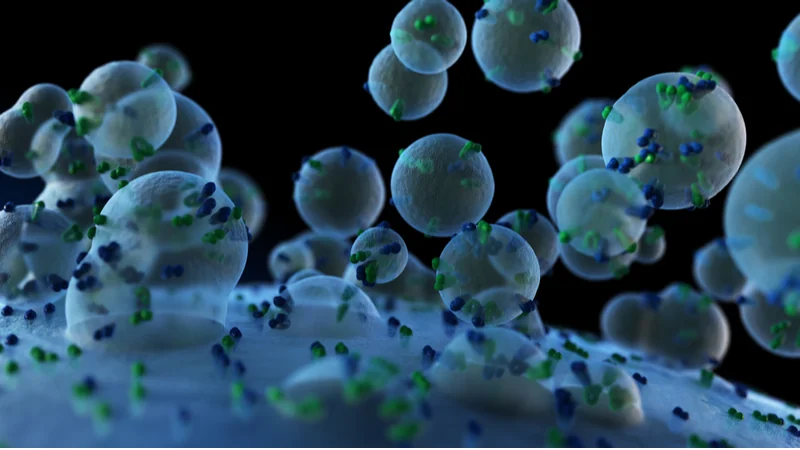Today, we want to highlight a recent review that charts the pro-inflammatory signals produced by senescent cells [1].
What is the senescence-associated secretory phenotype?
As we grow older, an increasing number of aged cells in our body enter a state called senescence. At this point, the cells no longer divide and, under normal conditions, should initiate a self-destruct sequence known as apoptosis. The immune system then disposes of these old cells, allowing fresh replacement cells to take their place.
Unfortunately, like many things in our bodies, this disposal process breaks down and starts to grind to a halt. This results in an increasing number of senescent cells evading apoptosis and remaining at large in the body. Cellular senescence is one of the reasons that we are thought to age.
The problem is that these cells don’t just hang around taking up space that could be used by healthy new cells, they also cause inflammation. Senescent cells secrete a mixture of pro-inflammatory cytokines, chemokines, and extracellular matrix proteases, which, together, form the senescence-associated secretory phenotype, or SASP.
The SASP contributes to the smoldering background of chronic inflammation that typically accompanies aging and can cause many problems.

Read More
Disrupting the lines of communication
Not only does the SASP cause inflammation and disruption to various cellular processes, it can also mess up cell-to-cell communication, leading to things like the immune system going haywire and triggering other cells exposed to the SASP to become senescent. Altered intercellular communication is also a proposed reason we age.
It doesn’t take many senescent cells at all to create this pandemonium. Even by the time we reach advanced age, only a small percentage of the total cells in our body are senescent. This means that a relatively small amount of these cells can create a problem many times greater than their number.
Reviewing the senescence-associated secretory phenotype
This review takes a look at the SASP and how its influence contributes to systemic aging in the context of altered intercellular communication and cellular senescence. The review explores the mechanisms of how senescent cells and their secreted SASP, NAD+ metabolism, and circulating factors regulate systematic aging.
It also takes a look at some of the potential solutions to these problems using various therapies for age reversal.
Abstract
With 100% incidence rate and individualized symptoms, aging is a highly complex process which simultaneously affects multiple organ systems (Ahadi et al., 2020). In addition to probing for the cell-autonomous mechanisms of aging, there is growing awareness of that deregulated intercellular communication contributes to decline in tissue/organ health with aging (Lopez-Otin et al., 2013). Intercellular communication refers to both direct interactions between neighboring cells and indirect cell communication via various message signals. A harmonious intercellular communication system is very important for organ development, stress response, cell survival and etc. In contrast, a disordered intercellular communication can be detrimental in aging progression and promote aging-related diseases (Fafian-Labora and O’Loghlen, 2020).
The best-known means of regulating intercellular communication are soluble factors in blood or extracellular matrix that can easily cross cell membrane to take effect through autocrine or paracrine signaling (Acosta et al., 2013). These soluble factors exist in various forms including proteins, metabolites or nucleic acids. Protein factors are the most well-studied, with the proactive secretome of senescent cells, known as senescence-associated secretory phenotype (SASP) factors, accounting for the vast majority. Senescent cells amass with age and secret more and more SASP factors into extracellular matrix, resulting in chronic low-grade immune response activation, or “Inflammaging,” which systematically compromise physiological functions and contribute to age-related dysfunctions in different organs or tissues such as neurodegeneration (Frederiksen et al., 2019; Ogrodnik et al., 2021), atherosclerosis (Childs et al., 2016), osteoarthritis cancer (Jeon et al., 2018), and kidney dysfunction (Valentijn et al., 2018), etc. Apart from SASP factors, non-SASP circulating protein factors and metabolites, particularly NAD+, have been extensively researched in recent years for their roles in aging development. Studies designed to counteract the change of these factors or metabolites caused by aging have shown that they are promising targets for anti-aging interventions. Moreover, recent studies have accumulated evidence that non-coding RNA molecules are linked to several biological aspects of aging such as senescence or autophagy, indicating more research attention needed.
Here, we review some major means of intercellular communication that affect aging such as senescence and senescence associated secretion phenotype (SASP) in the context of physiological or pathological scenario. We also go over the regulatory mechanisms of circulating aging-related factors including proteins factors, NAD+ and non-coding RNAs, as well as potential anti-aging strategies that target them. In light of the close tie of NAD+ metabolism with aging, we discuss how different organs use this highly mobile cofactor to shape cellular microenvironment. In light of the close tie of NAD+ metabolism with aging, we-discuss how different organs use this highly mobile cofactor to shape cellular microenvironment.
Conclusion
While we are still some way from a more complete understanding of aging and how the nine reasons we age are linked and regulated, that knowledge is growing. We are much further down the road to understanding and ultimately bringing aging under medical control than we were just ten years ago. This review collates a great deal of that knowledge and helps order it in a logical way that makes for a worthwhile read.
One of the urgent needs for our field is moving toward a unified theory of aging that puts all the pieces of the puzzle together. Reviews like this help to consolidate what we have learned and contribute towards that unified theory of aging.
That said, while it is certainly true that we do not yet understand aging fully, we know enough to start testing interventions against aging. Therapies such as senolytics as well as those that seek to restore metabolic homeostasis, such as NAD+ repletion, are likely near-future prospects and could significantly change how we age. This review does a good job of discussing these and other potential solutions.
Literature
[1] Tan, Q., Liang, N., Zhang, X., & Li, J. (2021). Dynamic aging: channeled through microenvironment. Frontiers in Physiology, 12.






